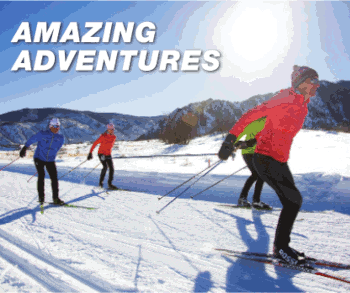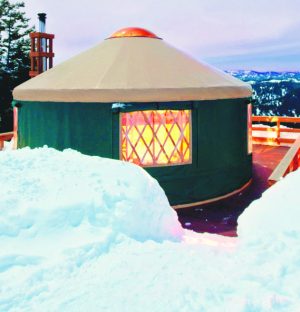November 21, 2008 (Bend, Oregon) – Saab/Salomon Factory Team member Kristina Strandberg wrote the following report on the importance of setting goals. A few weeks ago while house sitting for a friend I found Dr. Terri Orlick’s book on mental training (“In Pursuit of Excellence,” fourth edition) in the bookshelf. Intrigued by the title I started reading and it didn’t take long before I realized that I’ve neglected this simple, yet important, tool to become a better athlete.
One chapter in particular caught my attention: The Importance of Setting Goals. Short-term and long-term goals guide us through work and training by motivating us and creating focus. Setting goals and working hard to achieve them helps us become better athletes. Long-term goals help motivate us by offering constant reminders of what we are trying to achieve. They should be clearly defined, realistic, challenging and meaningful. Also remember not to put yourself up for frustration or needless stress by setting goals to control elements that are beyond your control. For example, if your goal is “to beat Mr. X at the Noquamanon,” you might fail simply because X improved more than you. You might be better off aiming to, for example, skiing the second half faster than the first.
If you have a hard time formulating long-term goals, seek the help of a coach or an experienced training partner. Together you should be able to formulate something that will work for you. Once you know what you want to achieve, write it down! By putting your words on a piece of paper they transform from abstract ideas to commitments. If you need help staying focused, put this piece of paper where it’s clearly visible, for example on your fridge, and take a few minutes every day to think about it. In my experience, it’s a lot easier to work hard when you have a clear goal in sight.
Some athletes find it helpful to publicly announce their big goals, making the commitment even stronger. By sharing with the public his quest for eight gold medals at the 2008 Olympic Games, Michael Phelps showed that he was committed to work harder than any other athlete in the world. Most of us do not receive the same attention as Phelps when sharing our goals, but it can still be a good idea. By letting our friends and family know that this year you are going to “finish your first marathon” or “get your 25% pin at the Birkie” you make it possible for them to support and encourage you along the way.
While long-term goals mark the end, short-term goals are the steps that take us progressively closer to this desired destination. As Dr. Orlick puts it, “it’s the present that gets us to the future in the way that we wish to get there.” These short-term goals serve as road maps to where we want to go. Small goals also help build self-confidence. Achieving even the smallest goal gives us a sense of competence and fuels our engines to keep us running. Before you go to sleep at night or before you get out of bed in the morning, take a moment to think about the day ahead. Ask yourself, what am I going to focus on today to take myself one step closer to my goal? Some days it might be a hard work out, other days it might be more beneficial to get some quality rest. Giving every day a purpose helps me stay focused on the task ahead.
No matter how hard we work, we still sometimes fall short of our goals. It is important to remember that unmet goals, times of little or no progress and even backsliding are natural. Remember that progress often is a series of ups and downs. Adjust your goals, find a new path of short-term marks to guide you and refine your focus. Take only with you the lessons you learned from your previous experience. The ski season is right around the corner and soon we will get a string of opportunities to test ourselves. Take the time to define your goals; chances are it is going to help you getting through your races successively. See you at the race trails!
Salomon Zero Classical Ski Prep
Zéro skis are optimal when it snowing wet and heavy snow and when there are large fluctuations in temperature. In these conditions the zero skis provide kick while normal kick wax ices up resulting in slippery skis.
Zéro skis are produced with a rubber inlay in the wax pocket zone that needs to be prepared before skiing. Rubbing the base of the ski makes the hairs, which lie in the base material, stand up. These standing hairs provide the grip needed for wet/zero snow conditions. Coarser rubs will be required for more humid snow, i.e. wet, heavy snow. Finer rubs for aggressive snow, i.e. snow with lower humidity. The rubbed area stays ice free by corking in silicone or fluoro powders. Glide zones must be waxed like for a normal classic ski.
What you need:
– Sand paper 60, 80, 100, 120 grain
– Cork
– Liquid silicone, or fluoro powder
Instructions:
1. Start by wrapping a piece of coarse sand paper (60 or 80 grain) around a cork.
2. Rub the hardest part of the camber (under the binding) continue rubbing 15-20 cm forwards and backwards from this point. Important: Make sure to remain in the center of the ski with the coarsest sand paper, not rubbing too far towards the tip or the end. Rubbing too long from the center will damage the glide zone and result in slower skis Rub the kick zone area of the ski several times to force the hairs to stand up. Repeat rubbing from both sides to create a cross pattern.
3. Switch to a finer sand paper (80-100 grain). Wrap the sand paper around the scraper or cork and work as described above. Start rubbing at the end of the coarse rubbing zone and work towards the ends of the special base material. Rub backwards and forwards.
4. Work the final 5-10cm on each end of the kick zone (special base material) with fine sand paper, 100-120 grain.
5. Rub silicone or fluoro powder by hand in the rubbing zone making sure to cover the entire kick zone.
If, when you try your ski they are sticky, the kick can be mellowed by using a finer sand paper (4 or 5 passes). If you need more kick, use a slightly coarser sand paper in the center of the kick zone. This method allows you to adjust your kick as you would with traditional kick wax.
Ivan Babikov won the 2008 Canadian National Championships 50km race on Salomon Zeros.
For more information visit www.SalomonNordic.com, or email the Saab Salomon Factory Team at WeAnswer@SkiPost.com
Top News Stories
Setting Goals and Salomon Zero Classic Ski Prep
release by the Saab/Salomon Factory TeamLeave a Reply
You must be logged in to post a comment.






![National camp action [P]...](https://skitrax.com/wp-content/uploads/2019/08/Duluth-4-2019-08-08-at-10.46.51-AM-300x246.png)
![Matt Liebsch on the CXC Elite Team [P] CXC...](https://skitrax.com/wp-content/uploads/2019/08/Matt-Liebsch-CXC.2-525x700.4-300x267.jpg)
![Dan LaBlanc [P]...](https://skitrax.com/wp-content/uploads/2019/08/Dan-LaBlanc-img_1855.3.jpg)

![Kristina Strandberg, Saab Salomon Factory Team[P]Salomon](http://skitrax.com/skitrax22/images/skitrax/4926dcd28b2b4Strandberg-094.jpg)